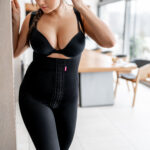The Evolution of Bras Through the Centuries: From Ancient Times to Modern Lingerie
Introduction
The bra, a staple in women’s fashion, has undergone dramatic transformations over the centuries. From ancient bandages to modern-day lingerie, the evolution of bras reflects cultural shifts, technological advancements, and changing beauty standards. In this article, we’ll explore the fascinating journey of bras through different historical periods.
- Ancient Civilizations: The Birth of Breast Support
Egypt (3000 BCE – 30 BCE)
Ancient Egyptian women often wore sheer linen dresses, but there’s little evidence of structured breast support. However, women engaged in physical activities may have wrapped cloth around their chests for comfort (Lamia, 2013).
Greece (800 BCE – 146 BCE)
Greek women used a strophion, a band of fabric wrapped around the chest and tied at the back, to provide basic support (Tortora & Eubank, 2010).
Rome (753 BCE – 476 CE)
Roman women adopted the fascia or mamillare, a simple breast band made of soft leather or linen to flatten or support the bust, especially among athletes and dancers (Croom, 2000).
- The Middle Ages (5th – 15th Century): Corsetry Begins
During the medieval period, bras took a backseat to the rise of corsets. Women wore tightly laced bodices to create a flat-chested look, which was idealized in many European cultures (Ribeiro, 2003). Some women may have used fabric bindings for support, but bras as we know them did not yet exist.
- The Renaissance and Baroque Era (16th – 18th Century): The Corset Dominates
Corsets became more structured, incorporating whalebone and metal to shape the female torso into a conical silhouette (Steele, 2001). These garments lifted and accentuated the bust rather than supporting it naturally. However, some women in informal settings used soft stays or early bra-like garments for comfort.
- The 19th Century: The Transition from Corsets to Bras
As the Victorian era progressed, women sought less restrictive undergarments. The “divided corset”, an early bra prototype, emerged in the 1860s, separating the bust into two cups while maintaining some waist compression (Fields, 2007).
In 1889, Herminie Cadolle, a French designer, introduced the “corselet-gorge,” which featured an upper section resembling a modern bra. This was one of the earliest versions of the two-part undergarment, a crucial step toward the bra’s invention (Fontanel, 1997).
- The Early 20th Century: The Birth of the Modern Bra
1910s: The First Bra Patent
In 1914, Mary Phelps Jacob (later known as Caresse Crosby) patented the first modern bra, made of two handkerchiefs and a ribbon (Lindon, 1995).
1920s: The Flapper Era and Bandeau Bras
The bandeau bra became popular in the 1920s, catering to the boyish, flat-chested look of the flapper era (Steele, 2010).
1930s: Introduction of Cup Sizes
The 1930s revolutionized lingerie with the invention of cup sizes by S.H. Camp & Company, making bras more functional and supportive (Farrell-Beck & Gau, 2002).
- The Mid-20th Century: Innovation and Glamour
1940s: The Bullet Bra and War-Time Influence
During World War II, the bullet bra gained popularity, featuring a structured, conical shape that enhanced the bust (Ewing, 1978).
1950s: Hollywood and the Rise of Lingerie Fashion
Stars like Marilyn Monroe and Jayne Mansfield popularized the hourglass figure, making bras an essential part of achieving the curvy, feminine aesthetic of the decade (Gernsheim, 1988).
1960s: The Feminist Movement and Bra-Burning Myth
The 1960s feminist movement challenged restrictive clothing, leading to the bra-burning myth (though actual bra-burning was rare). Soft, wire-free, and natural-shaped bras became more popular (Freedman, 2003).
- The Late 20th Century: Comfort and Diversity
1970s: The Sports Bra Is Born
The first sports bra, the “jogbra,” was invented in 1977, revolutionizing athletic wear for women (Mason, 1977).
1980s – 1990s: Push-Up Bras and Lingerie as Fashion
The push-up bra, popularized by Victoria’s Secret, became a staple in the 1990s (Raphael, 1999). Brands also embraced lace, satin, and bold colours, making lingerie a fashion statement rather than just functional wear.
- The 21st Century: Innovation, Inclusivity, and Comfort
2000s – Present: Smart Bras, Bralettes, and Sustainability
- The bralette trend surged in the 2010s, promoting comfort over structure (Vincent, 2016).
- Advances in smart bras with temperature regulation and posture support emerged (Zhou et al., 2021).
- The industry has also embraced sustainability, with brands creating eco-friendly bras made from recycled materials (Pike, 2020).
- Size inclusivity has become a priority, with brands like Savage X Fenty and Third Love offering diverse sizing options (Khan, 2019).
Conclusion
From ancient chest wraps to high-tech, size-inclusive designs, the bra has evolved alongside cultural, technological, and fashion trends. As society continues to shift toward comfort and body positivity, the future of bras is likely to focus on customization, sustainability, and innovation.
References
- Croom, A. T. (2000). Roman Clothing and Fashion. Tempus.
- Ewing, E. (1978). Fashion in Underwear: From Babylon to Bikini Briefs. Batsford.
- Farrell-Beck, J., & Gau, C. (2002). Uplift: The Bra in America. University of Pennsylvania Press.
- Fields, J. (2007). An Intimate Affair: Women, Lingerie, and Sexuality. University of California Press.
- Fontanel, B. (1997). Support and Seduction: A History of Corsets and Bras. Harry N. Abrams.
- Freedman, E. B. (2003). No Turning Back: The History of Feminism and the Future of Women. Ballantine Books.
- Gernsheim, A. (1988). Fashion and Reality, 1840-1914. Faber & Faber.
- Lindon, J. (1995). The Story of the Bra. HarperCollins.
- Mason, L. (1977). Jogbra: A New Era in Athletic Wear. Sportswear Journal.
- Pike, J. (2020). Sustainable Fashion: Past, Present & Future. Bloomsbury.
- Raphael, B. (1999). Victoria’s Secret: Lingerie and the Rise of Fashion. Vogue Press.
- Ribeiro, A. (2003). Dress and Morality. Berg.
- Steele, V. (2001). The Corset: A Cultural History. Yale University Press.
- Vincent, M. (2016). The Bralette Revolution: Comfort Over Structure. Fashion Studies Journal.
- Zhou, W., et al. (2021). Smart Textiles for Lingerie: A Technological Perspective. Textile Research Journal.










